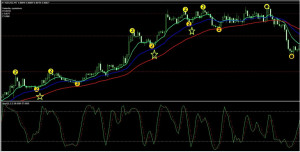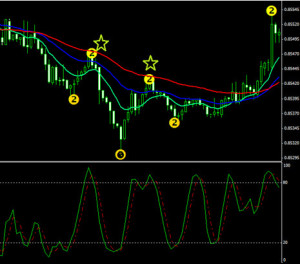ZZ-Rainbow Strategy for Binary Options – Where’s My Gold?
Full Review of the ZZ-Rainbow Strategy for Binary Options
Come and look at the rainbow! No, don’t worry, you don’t have to go outside and gaze at rainbows. I’m talking about this interesting short expiry strategy that I found recently. It uses an indicator called the zigzag indicator. Actually, you might have read about the ZZ-indicator in this article Michael wrote a while ago. There are different versions of this strategy and how people use the ZZ-indicator but the one I am going to talk about is from another website. The author, Brian Clark, took his time to make a few videos – walkthroughs that you should watch on his YouTube channel after reading this article.
How does the ZZ-Rainbow Strategy Work?
This strategy uses a 3-level-zigzag indicator called the 3-ZZ-Semaphore (or semafor) in addition to 3 moving averages, 50, 25, and 10. The 3 exponential moving averages create the rainbows. If you are not familiar with how to use the rainbow to your advantage you should definitely read EMA Rainbow Strategy review first. Now that you are familiar with the ZZ-indicator and the EMA-indicator you are ready to learn the rules and the required setup for this strategy.
Brian’s Recommendations and Rules:
– Trading Sessions: New York, London, Tokyo, Hong Kong
– Expiry Time: 10-15 Minutes
– Timeframe: 5-Minute
– Don’t trade when 10 EMA starts moving sharply in the opposite direction of your trade
– Don’t enter a trade if the 10 EMA is entangled or is too close to the 25 EMA.
– Trade in the direction of the trend
Brian also recommends that you install the Fibopiv indicator and I completely agree. The Fibopiv is an excellent indicator, especially for shorter timeframes (<H4). You can use it to find important support and resistance areas. I’ve put all of the indicators together for you and created a template too, download link is below the article.
I took the liberty to add a Stochastic Oscillator (5, 3, 3) to further improve the precisions of the entries.
Looking at the charts I believe Stochastic will help, but it’s up to you whether you prefer to use it or not.
Indicators:
EMA: Level 10, 25 and 50
3-Level-ZZ
Finbopiv_V2
Optional: Stochastic Oscillator: Level 80 and 20, (5, 3, 3)
Entry Rules:
Call:
If a signal is triggered in an uptrend, if and only if the 10 EMA is clearly distanced and above the 25 EMA we place a Call. Optional: In addition, Stochastic should be about to cross back up from the oversold level 20.
Put:
If a signal is triggered in a downtrend, if and only if the 10 EMA is clearly distanced and under the 25 EMA we place a Put. Optional: In addition, Stochastic should be about to cross back down from the overbought level 80.
**To counter the repainting problem, Brian suggested we wait at least 2-2.5 minutes to see if the candle after the triggered signal moves in the desired direction or not – only then do we enter the trade**

Here is the 5-minute chart with all of the indicators installed. The yellow circles marked “2” are the signals that the ZZ-indicator triggers for you. You just have to keep an eye on the 10 EMA and the Stochastic Oscillator. The three stars I drew on the picture show the winning Call signals (stars and rainbows Okane? What’s next, ponies?). Notice how the 10 EMA (green) was clearly above the 25 EMA. If you look carefully you can also see how the signals were triggered after Stochastic Oscillator crossed above oversold levels. As for all of the other signals, ignore them! You don’t want to trade against the main trend. However, if you are good at using price action and familiarize yourself with Fibopiv you can sometimes find important support and resistance areas that can justify a trade against the trend. For example, see the first two triggered put signals from the left, they were triggered after price touched and bounced back from a strong resistance point, the dotted red line. A couple of Put examples are in the picture below.

In this picture, you can see two winning Put entries, the stars. Notice how the candles bounced back from the 50 EMA. The 10 EMA had a clear distance to the 25 EMA. Stochastic showed that overbought levels had been reached and the signals were triggered on the highest lower tops. The other signals were no good because you would be trading against the trend.
Why does the ZZ-Rainbow Strategy Suck?
Unfortunately, the signals do repaint. However, this problem can be slightly countered by following a few simple rules – trading in the direction of the trend and waiting for the 2-2.5-minute confirmation after the signal is triggered. As for the moving averages, they can also suddenly change directions and get entangled in each other.
Why ZZ-Rainbow Strategy doesn’t Suck?
This strategy does not suck because, as Brian also demonstrates in his videos, we can reduce the number of fake signals by trading in the direction of the trend and by waiting 2-2.5 minutes for confirmation. In Addition, the Stochastic Oscillator might help get the extra confirmation we need for improvement.
My Conclusion – Brian’s Gold might not be for you
My first concern is repainting. Back-testing does not really provide much information because you can’t tell how many times the ZZ-indicator repainted. Neither can you tell how the moving averages were behaving in the past? I haven’t had the time to test the strategy yet but according to Brian he has been trading with this strategy successfully so far. I think you should test this strategy on the demo to verify whether you can stay profitable or not. I personally think that one of the reasons why Brian has a high success rate with his strategy is because of his candlestick knowledge and trading skills. So, know your candles! Let me know how it works out for you.
Downloads Available: